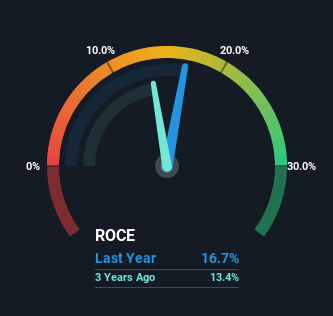- United States
- /
- Building
- /
- NYSE:AWI
Returns On Capital At Armstrong World Industries (NYSE:AWI) Have Stalled

If we want to find a stock that could multiply over the long term, what are the underlying trends we should look for? One common approach is to try and find a company with returns on capital employed (ROCE) that are increasing, in conjunction with a growing amount of capital employed. If you see this, it typically means it's a company with a great business model and plenty of profitable reinvestment opportunities. However, after investigating Armstrong World Industries (NYSE:AWI), we don't think it's current trends fit the mold of a multi-bagger.
What Is Return On Capital Employed (ROCE)?
For those who don't know, ROCE is a measure of a company's yearly pre-tax profit (its return), relative to the capital employed in the business. The formula for this calculation on Armstrong World Industries is:
Return on Capital Employed = Earnings Before Interest and Tax (EBIT) ÷ (Total Assets - Current Liabilities)
0.17 = US$255m ÷ (US$1.7b - US$186m) (Based on the trailing twelve months to September 2023).
Therefore, Armstrong World Industries has an ROCE of 17%. In absolute terms, that's a pretty normal return, and it's somewhat close to the Building industry average of 16%.
See our latest analysis for Armstrong World Industries

Above you can see how the current ROCE for Armstrong World Industries compares to its prior returns on capital, but there's only so much you can tell from the past. If you're interested, you can view the analysts predictions in our free report on analyst forecasts for the company.
What Can We Tell From Armstrong World Industries' ROCE Trend?
Over the past five years, Armstrong World Industries' ROCE and capital employed have both remained mostly flat. This tells us the company isn't reinvesting in itself, so it's plausible that it's past the growth phase. So don't be surprised if Armstrong World Industries doesn't end up being a multi-bagger in a few years time.
On a side note, Armstrong World Industries has done well to reduce current liabilities to 11% of total assets over the last five years. This can eliminate some of the risks inherent in the operations because the business has less outstanding obligations to their suppliers and or short-term creditors than they did previously.
The Key Takeaway
In summary, Armstrong World Industries isn't compounding its earnings but is generating stable returns on the same amount of capital employed. Unsurprisingly, the stock has only gained 29% over the last five years, which potentially indicates that investors are accounting for this going forward. So if you're looking for a multi-bagger, the underlying trends indicate you may have better chances elsewhere.
Armstrong World Industries does have some risks though, and we've spotted 1 warning sign for Armstrong World Industries that you might be interested in.
For those who like to invest in solid companies, check out this free list of companies with solid balance sheets and high returns on equity.
New: Manage All Your Stock Portfolios in One Place
We've created the ultimate portfolio companion for stock investors, and it's free.
• Connect an unlimited number of Portfolios and see your total in one currency
• Be alerted to new Warning Signs or Risks via email or mobile
• Track the Fair Value of your stocks
Have feedback on this article? Concerned about the content? Get in touch with us directly. Alternatively, email editorial-team (at) simplywallst.com.
This article by Simply Wall St is general in nature. We provide commentary based on historical data and analyst forecasts only using an unbiased methodology and our articles are not intended to be financial advice. It does not constitute a recommendation to buy or sell any stock, and does not take account of your objectives, or your financial situation. We aim to bring you long-term focused analysis driven by fundamental data. Note that our analysis may not factor in the latest price-sensitive company announcements or qualitative material. Simply Wall St has no position in any stocks mentioned.
About NYSE:AWI
Armstrong World Industries
Engages in the design, manufacture, and sale of ceiling and wall solutions in the Americas.
Solid track record with adequate balance sheet.


